从图里翻译规范理论看《于丹〈论语〉心得》英译本
生态翻译学视角下《论语》两个英译本的比较研究
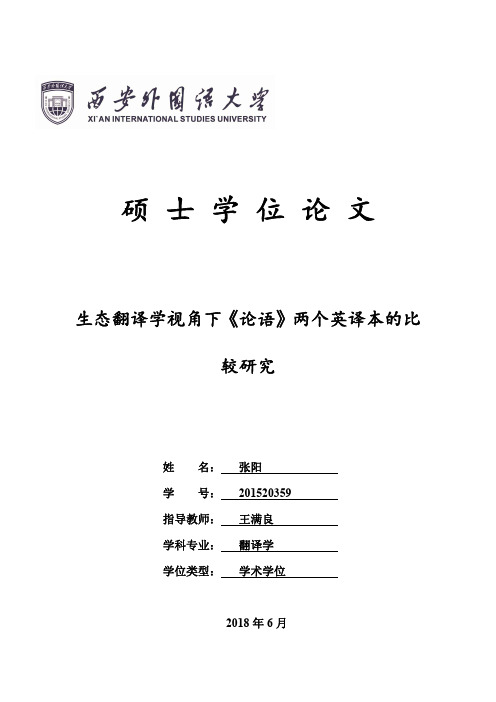
硕 士 学 位 论 文生态翻译学视角下《论语》两个英译本的比较研究*名:**学号: *********指导教师:***学科专业:翻译学学位类型:学术学位2018年6月A COMPARATIVE STUDY ON TWO ENGLISH VERSIONS OFTHE ANALECTS FROM THE PERSPECTIVE OFECO-TRANSLATOLOGYByZHANG YANGA ThesisSubmitted to the Graduate Schoolof Xi’an International Studies Universityin partial fulfillment of the requirements for the degree ofMASTER OF ARTSinForeign Linguistics and Applied LinguisticsXi’an, China2018ACKNOWLEDGEMENTSBecause of the completion of my thesis, I want to express my gratitude to people who have helped me and encouraged me a lot in my lost time.Firstly, the person I want to thanks is my supervisor. His carefulness, patience, and responsibility move me a lot and without my supervisor’s great effort, my thesis could not have finished successfully.Secondly, I would like to thanks for my teachers in School of English Studies. During my past three years’ study, they have given me a lot of help. I will always bear in mind their instructions.Finally, I want to express my thanks to my classmates. It’s they that give me suggestions and the suggestions always inspire me a lot. At the same time, I also want to thanks for my parents’ encouragement and support.ABSTRACTThe Analects, praised as a Confucian classic, has recorded the words and actions of Confucius and his students. It reflects the essence of traditional Chinese culture to a great extent. A great number of translators, scholars and sinologists have translated and done researches on The Analects. Among the translations, Legge’s, Arthur Waley’s, and u’s versions are outstanding. In this thesis, the author attempts to make a comparison between Waley’s and u’s translations from the perspective of eco-translatology. According to the researches on the translations of The Analects, Waley’s translation is more popular in the world with Western readers, and thus could better disseminate Chinese culture to the Western world; u’s translation, however, plays an important role in sinology researches.The theoretical perspective of this thesis─Eco-translatology is an original and Chinese characteristic translation theory firstly put forward by Hu Gengshen, a professor at Tsinghua University. This theory is about researches on translation from an ecological perspective, and gives new explanation to the essence, process, methods and evaluating principles of translation from adaptation and selection by learning from Darwin’s principle of “survival of the fittest”. In the translation process, translators constantly select and adapt to the translational eco-environment. The comparison between Waley’s and u’s translations of The Analects from the perspective of eco-translatology was beneficial for readers from different backgrounds to get more interested in The Analects and traditional Chinese culture. The author attempts to research on the two English versions of The Analects from the perspective of eco-translatology using textual analysis and comparative analysis. Through the analysis, what can be concluded is the difference between the two translators’ English versions and some strategies of Chinese classics translation. Their translations are popular and well-accepted by different readers in the world.Keywords: The Analects; Eco-translatology; adaptation and selection; comparison and analysis; translation strategies of Chinese classics摘 要《论语》被誉为中国儒家经典著作,记录了春秋时期著名思想家、教育家孔子及其弟子的言行,极大地体现了中国传统文化的精髓。
学习于丹《论语》心得体会文档2篇

学习于丹《论语》心得体会文档2篇Learning Yu Dan's Analects of Confucius编订:JinTai College学习于丹《论语》心得体会文档2篇小泰温馨提示:心得体会是指一种读书、实践后所写的感受性文字。
语言类读书心得同数学札记相近;体会是指将学习的东西运用到实践中去,通过实践反思学习内容并记录下来的文字,近似于经验总结。
本文档根据心得体会内容要求和针对主题是读书学习群体的特点展开说明,具有实践指导意义,便于学习和使用,本文下载后内容可随意修改调整及打印。
本文简要目录如下:【下载该文档后使用Word打开,按住键盘Ctrl键且鼠标单击目录内容即可跳转到对应篇章】1、篇章1:学习于丹《论语》心得体会文档2、篇章2:学习于丹论语心得体会文档篇章1:学习于丹《论语》心得体会文档通过学习于丹教授《论语》的这本书后,我深受启发。
于丹教授的讲课,剖析现代社会人们的为人,处世的方法和道德,告诉我们既是人们身边所发生的日常琐事,也是最简单的真谛,《论语》中把天比做理想主义,地比做现实主义,天、地、人和在一起才能成为一个完美的整体,每一个人把自己容入大自然,因势利道,不断学习,内心充满快乐,宽容,整个社会才能和谐。
讲到处世之道,我深有体会。
记得在我遇到麻烦和问题时,也曾痛苦过,曾徬徨过,不知道该怎么办,干什么都感到没意思,整天提不起精神,但是时间或许能够减轻痛苦,等过了一段时间想开了,既然痛苦不能解决问题,每天痛苦也是活,开心也是活,为什么不能每天开心点呢。
人的一生难免要遇到挫折和磨难,怎样来面对生活给自己带来的不幸呢?于丹教授告诉了我们,如何用平和的心态来对待生活中的缺憾与苦难。
她说:“每个人的一生中都难免有缺憾和不如意,也许我们无力改变这个事实,而我们可以改变的是看待这些事情的态度。
”人首先要能够正确面对人生的遗憾,不要纠缠在里面,一遍遍地问天问地,这样只能加重你的苦痛。
从图里翻译规范理论看《于丹〈论语〉心得》英译本
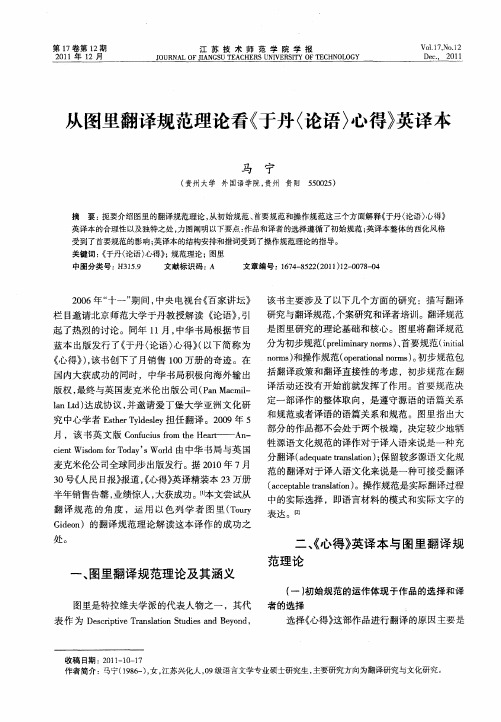
方世界好奇《 心得》 中讨论的孔子哲学思想对解决 文化规范和译人语文化规范的取舍问题上 ,译者
当今西方人面临的问题能否具有启示作用 。20 根 据文 本 的实 际情 况掌 握 两种 不 同文化 规 范 的 的 08
年美 国次贷危机引发 了全球 范围内的经融危机 ,
契合点 , 并且在译文中生动地表现出来。译者没有
通大众读者少之又少 。再次是响应国家政策 的结 的一次整整 四天没有出宾馆 , 认真到了较真 的地 果。为了吸引世界对中国传统文化的关注 更加全 步 ” 。圈 面有效地宣传中国传统文化 ,04年 , 20 国家正式启 动 了 “ 国 图 书 对 外 推 广 计 划 ” C i ok 中 ( h aB o n
( ) 要规 范体现 于译 文 的整体 风格 二 首
译文的整体风格受到三方面因素的影响 : 译
It aoa 。在此基础之上 ,09年又全面推行 入语作品的受众 、受众的母语及其文化风格和源 ne tn1 n r i ) 20 “中 国 文 化 著 作 翻 译 出 版 工 程 ” Po c f 语作品的风格 。《 (r et o j r 心得》 英译本的受众是普通 的大
了前 进 的方 向。
选择 Et r y e e( s e Tl s y 中文名狄星 ) 心得》 h d l 为《
言解读经典 , 拉近了经典与普通民众的距离。成功 翻译和她的专业素质、生活经历以及工作态度有
的原 因有 :一 是 通俗 ,用一 般 群众 能 听懂 的语 言 关 。Et r y e e 毕业于英 国剑桥大学 , “ s eT l s y h dl 中文专 获得 从 解说 《 论语》二是 : ; 有趣 , 她用古今 中外 的故事 、 寓 业 , 英 国立 兹大 学应 用 翻学 研究 硕 士学位 ,
新时期“东学西渐”中翻译策略的优选论分析--以《于丹〈论语〉心得》英译本为例
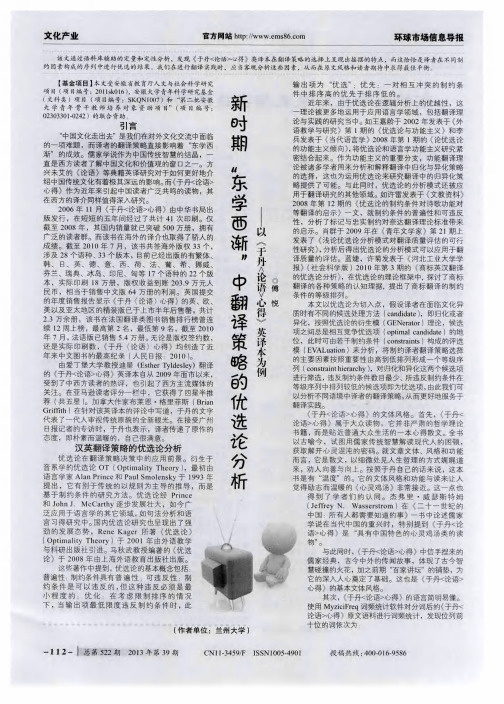
6 这 6 3 8 1 . 5 1 % 1 3 . 9 9 ( 夫) 子”共 1 2 9次 ,“ 子日 ”6次。作者选取 《 论语 》
中 自己感悟最深 ,对普通大众生活可能最有启示的句子。如 : 子 日:“ 天何 言哉? 四时行焉 ,百物生焉。天何言哉 ”( 《 论 语 ・阳货》 )孔子对他的学生说 ,你看 ,苍天在上,静穆无言 ,而 四 季轮 转 ,万 物滋 生。 苍 天还 需 要说 话 吗 ? 在全书开篇 《 天地人之道》中,作者通过直接 引用 《 论语 》 , 来佐证儒 家的传统智慧并非高高在上 ,而是润物细无声的。并籍 由 自己的诠释和感悟 ,来传达对于生活的态度。而这种叙事 的模 式贯穿着整本书 ,构成 了心得式文体 的主要特点。
环 球 市场信 息 导报
词 语
1
2
官方网站 h t t p : / / w w w . e m s 8 6 . c o n r
频次
l 9 5 3
9 9 3
文化 产 业
频 率
4 . 6 3 %
2 _ 3 6 %
累 积频 率
4 . 6 3 %
6 . 9 9 %
的
3
4
5
从图里翻译规范论解读理雅各《论语》英译本
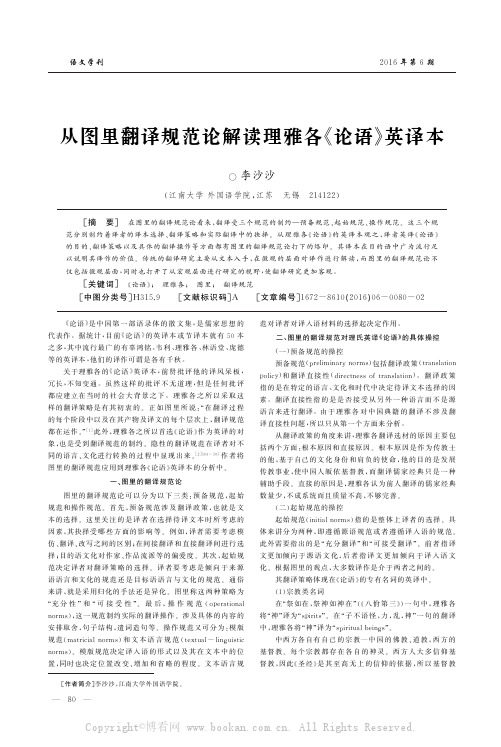
此外需要指出的是 “充 分 翻 译 ”和 “可 接 受 翻 译 ”。 前 者 指 译
择;目的 语 文 化 对 作 家、作 品 流 派 等 的 偏 爱 度。其 次,起 始 规
范决定译者对翻 译 策 略 的 选 择。 译 者 要 考 虑 是 倾 向 于 来 源
文更加倾向 于 源 语 文 化,后 者 指 译 文 更 加 倾 向 于 译 入 语 文
眼。理雅各根据 自 己 的 理 解,增 加 了 原 文 中 没 有 的 概 念,在
其译文中“愤”就是“
tknowl
edge”,“启”就是“
tt
r
u
t
h”。
ge
ge
文本 - 语言规范操控。
2.
1)契合原文风格。在对源语 风 格 的 处 理 上,理 雅 各 的 译
文符合原文的风 格 特 征,完 全 按 照 原 文 的 句 式、形 式 来 进 行
化。根据图里的观点,大多数译作是介于两者之间的。
语语言和文化的 规 范 还 是 目 标 语 语 言 与 文 化 的 规 范。 通 俗
其翻译策略体现在《论语》的专有名词的英译中。
来讲,就是采用归化的手法还是 异 化。 图 里 称 这 两 种 策 略 为
(
1)宗教类名词
“充 分 性 ”和 “可 接 受 性 ”。 最 后,操 作 规 范 (
[摘
无锡 214122)
要] 在图里的翻译规范论看来,翻译受三个规范的制约 ─ 预备规范、起始规范、操 作 规 范。 这 三 个 规
范分别制约着译者的译本选择、翻译策略和实际翻译 中 的 抉 择。 从 理 雅 各 《论 语》的 英 译 本 观 之,译 者 英 译 《论 语》
的目的、翻译策略以及具体的翻译操作等方面都有图里的翻译规范论打下的烙 印。 其 译 本 在 目 的 语 中 广 为 流 行 足
新时期“东学西渐”中翻译策略的优选论分析:以《于丹?论语?心得》英译本为例
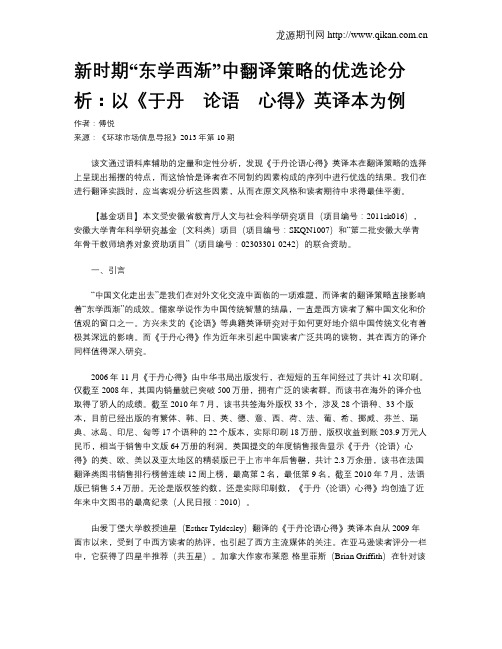
新时期“东学西渐”中翻译策略的优选论分析:以《于丹 论语 心得》英译本为例作者:傅悦来源:《环球市场信息导报》2013年第10期该文通过语料库辅助的定量和定性分析,发现《于丹论语心得》英译本在翻译策略的选择上呈现出摇摆的特点,而这恰恰是译者在不同制约因素构成的序列中进行优选的结果。
我们在进行翻译实践时,应当客观分析这些因素,从而在原文风格和读者期待中求得最佳平衡。
【基金项目】本文受安徽省教育厅人文与社会科学研究项目(项目编号:2011sk016),安徽大学青年科学研究基金(文科类)项目(项目编号:SKQN1007)和“第二批安徽大学青年骨干教师培养对象资助项目”(项目编号:02303301-0242)的联合资助。
一、引言“中国文化走出去”是我们在对外文化交流中面临的一项难题,而译者的翻译策略直接影响着“东学西渐”的成效。
儒家学说作为中国传统智慧的结晶,一直是西方读者了解中国文化和价值观的窗口之一。
方兴未艾的《论语》等典籍英译研究对于如何更好地介绍中国传统文化有着极其深远的影响。
而《于丹心得》作为近年来引起中国读者广泛共鸣的读物,其在西方的译介同样值得深入研究。
2006年11月《于丹心得》由中华书局出版发行,在短短的五年间经过了共计41次印刷。
仅截至2008年,其国内销量就已突破500万册,拥有广泛的读者群。
而该书在海外的译介也取得了骄人的成绩。
截至2010年7月,该书共签海外版权33个,涉及28个语种、33个版本,目前已经出版的有繁体、韩、日、英、德、意、西、荷、法、葡、希、挪威、芬兰、瑞典、冰岛、印尼、匈等17个语种的22个版本,实际印刷18万册,版权收益到账203.9万元人民币,相当于销售中文版64万册的利润。
英国提交的年度销售报告显示《于丹〈论语〉心得》的英、欧、美以及亚太地区的精装版已于上市半年后售罄,共计2.3万余册,该书在法国翻译类图书销售排行榜曾连续12周上榜,最高第2名,最低第9名,截至2010年7月,法语版已销售5.4万册。
于丹《论语》心得课件

05
总结与展望
《论语》与中华文化的传承与创新
传承
作为中华文化的重要经典,《论语》承载了丰富的文化内涵和智慧,对于中华文化的传 承具有重要意义。
创新
在传承《论语》的同时,我们需要结合时代的发展和社会的需求,对《论语》进行创新 性的解读和应用,以适应现代社会的需要。
ห้องสมุดไป่ตู้
《论语》在现代社会的价值与意义
价值
03
《论语》的核心思想
仁爱与人际关系
仁爱
孔子认为仁爱是人与人之间最基本的道德准则,是建立和谐 人际关系的基础。在《论语》中,孔子强调了对他人的关爱 和尊重,提倡以仁爱之心对待他人。
人际关系
孔子认为人际关系是社会稳定和发展的重要因素,提倡建立 和谐的人际关系,主张以诚信、宽容、谦逊的态度来处理人 际关系。
道德与修养
道德
孔子认为道德是个人修养的核心,是 成为君子的必要条件。在《论语》中 ,孔子强调了道德的重要性,提倡以 道德为行为准则,以道德来约束自己 的行为。
修养
孔子认为修养是个人成长和发展的重 要途径,主张通过不断的学习和反思 来提高自己的修养水平,以达到君子 的境界。
政治与治理
政治
孔子认为政治是国家发展的重要保障,主张以德治民,提倡君主应该以仁爱之心对待人民,以诚信、公正的态度 处理政务。
人才培养
企业可以通过汲取《论语》中的教育思想 ,加强对员工的培训和教育,培养出更多 优秀的人才。
在社会治理中的应用
公共道德建设
借鉴《论语》中的道德观念 ,政府可以加强公共道德建 设,提高公民的道德素质和 社会责任感。
社区建设
通过汲取《论语》中的“仁 爱”思想,社区可以加强居 民之间的互助和关怀,营造 和谐友爱的社区氛围。
概念整合理论视阈下《于丹〈论语〉心得》中的隐喻研究
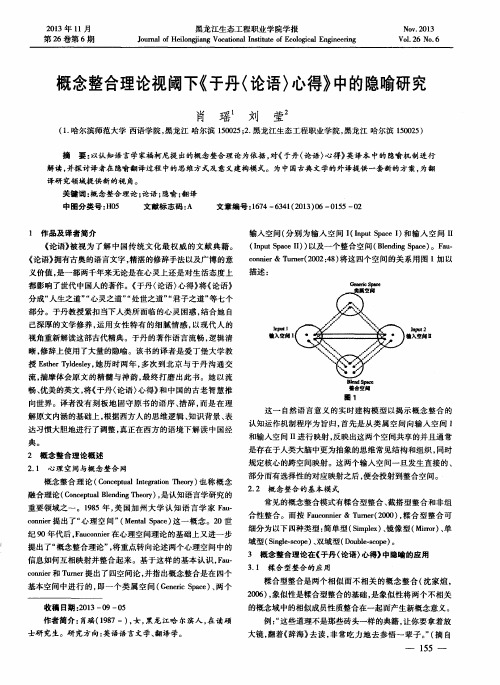
No v . 2 O l 3 V0 1 . 2 6 No . 6
第2 6 卷第 6 期
概念整合理论视阈下《 于丹< 论语> 心得》 中的隐喻研究
肖 瑶 刘 莹
( 1 . 哈尔滨师 范大学 西语学院 , 黑龙江 哈尔滨 1 5 0 0 2 5 ; 2 . 黑龙江生态 工程 职业 学院 , 黑龙 江 哈尔滨 1 5 0 0 2 5 )
描述 :
ቤተ መጻሕፍቲ ባይዱ
《 论 语》 被 视为 了解 中国传统 文 化最 权 威 的文 献典 籍 。
《 论语》 拥有古奥的语言文字, 精湛的修辞手法以及广博的意
义价值 , 是一部两千年来无论 是在心灵上 还是对 生活态度 上
都影响 了世代 中国人的著作 。《 于丹 ( 论语 ) 心得》 将《 论 语》
分成“ 人 生之道” “ 心灵之道” “ 处世之道” “ 君子之道” 等七 个
部分 。于丹教授 紧扣当下人类所面 临的心灵 困惑 , 结合她 自
己深厚 的文学修养 , 运用 女性 特有 的细腻 情感 , 以现 代人 的
视 角重新解读这部古代 精典 。于丹 的著作语言 流畅 , 逻辑 清 晰, 修辞上使 用了大量 的隐喻 。该 书的译者 是爱 丁堡 大学教 授E s t h e r T y l d e s l e y , 她 历时 两年 , 多次 到北 京 与于丹 沟 通交 流, 揣摩体会原 文 的精髓 与神 韵 , 最终 打磨 出此 书。她 以 流
I
2
入空 橱 1
输入塑 阔1 1
删
畅、 优美 的英 文 , 将《 于丹( 论语 ) 心得》 和 中 国的古老智 慧推
向世界。译者没有 刻板 地 固守原 书 的语 序 、 措辞, 而是 在理 解 原文内涵的基础上 , 根据西方人 的思维逻辑 、 知识背景 、 表 达 习惯 大胆地进行 了调整 , 真正在西方 的语境下 解读 中国经
4翻译目的论视角下的汉语典籍英译——以《论语》英译为例
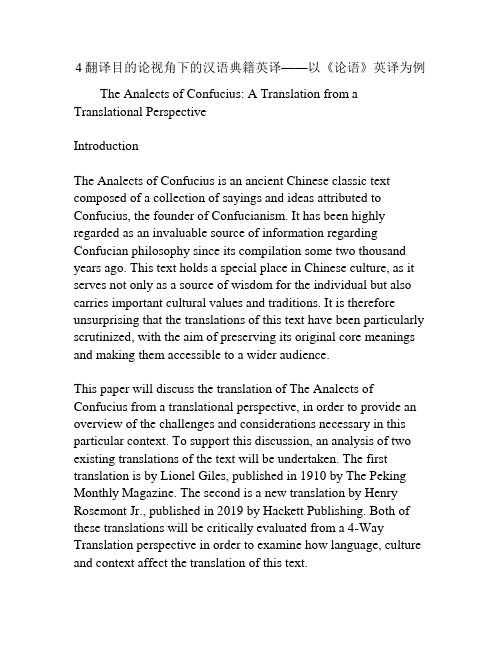
4翻译目的论视角下的汉语典籍英译——以《论语》英译为例The Analects of Confucius: A Translation from a Translational PerspectiveIntroductionThe Analects of Confucius is an ancient Chinese classic text composed of a collection of sayings and ideas attributed to Confucius, the founder of Confucianism. It has been highly regarded as an invaluable source of information regarding Confucian philosophy since its compilation some two thousand years ago. This text holds a special place in Chinese culture, as it serves not only as a source of wisdom for the individual but also carries important cultural values and traditions. It is therefore unsurprising that the translations of this text have been particularly scrutinized, with the aim of preserving its original core meanings and making them accessible to a wider audience.This paper will discuss the translation of The Analects of Confucius from a translational perspective, in order to provide an overview of the challenges and considerations necessary in this particular context. To support this discussion, an analysis of two existing translations of the text will be undertaken. The first translation is by Lionel Giles, published in 1910 by The Peking Monthly Magazine. The second is a new translation by Henry Rosemont Jr., published in 2019 by Hackett Publishing. Both of these translations will be critically evaluated from a 4-Way Translation perspective in order to examine how language, culture and context affect the translation of this text.BackgroundThe Analects of Confucius is a short text composed of approximately 500 aphorisms, divided into twenty books. It was originally written between 722 and 481 BCE and compiled in about 479 BCE by the followers of Confucius after his death. The primary purpose of the text is to provide guidance on personal virtue and moral values, such as the importance of filial piety, politeness and humility. It also includes various discussions on subjects such as politics, religion and education, among others. As a result, the text is significant not only as a source of spiritual and philosophical teachings, but also as a means to gain insight into the life and thought of Confucius and the beliefs of his time.Translation Approach – 4-Way TranslationWhen translating a text, it is essential to consider the language, culture and context in which the text has been composed in orderto ensure that the original intended meaning is conveyed accurately. This is known as the 4-Way Translation approach, which takes into account not only the form of the language (grammar, syntax and rhetoric) but also the cultural, religious and political implicationsof the text (from both the source and target language). For example, in the case of The Analects of Confucius, it is necessary to consider the differences between the Chinese and English languages and cultures in order to accurately convey the original meaning and intent of the text.Analysis of Existing TranslationsLionel Giles’ 1910 Transl ationLionel Giles’ translation of The Analects of Confucius is significant because it was one of the earliest English translations of the text. He provided his own interpretations of the text based on his own understanding of the Chinese language, without attempting to preserve any of the original connotations or cultural references. His translation is often criticized for being too literal and failing to capture the nuances of the text. For example, he translates 人之初, “the beginning of a person”, as “the first men”, as opposed to taking into account the culturally specific connotations of the original phrase. Similarly, he translates 礼尚往来, “ceremonies carry the exchange of benefits”, as “ceremonies are the basis of return for kindness”, conveying the idea of transactions, rather than the concept of mutual beneficial relationships which is implied by the original Chinese phrase.Henry Rosemont Jr.’s 2019 TranslationHenry Rosemont Jr’s translation of The Analects of Confucius is a more contemporary interpretation which seeks to preserve the original connotations and implications of the text. In comparison to Giles’ translation, Rosemont’s translation captures more of the nuances and cultural specificity of the text. For example, he translates 人之初, “the beginning of a person”, as “the initiation of humanity”, taking into account the implications of Confucius’ view of man as the most noble and perfect being. Similarly, he translates 礼尚往来, “ceremonies carry the exchange of benefits”, as “etiquette celebrates reciprocity”, recognizing the important role of rituals in Confucian philosophy.ConclusionOverall, the 4-Way Translation approach is essential for the accurate and effective translation of texts. It is important to consider not only the form of the language but also the cultural, religious and political implications of the text in order to properly convey the original intended meaning of the text. The differences between the two translations of The Analects of Confucius discussed in this paper illustrate how varying approaches to translation can change the effect of the text. Consequently, it is clear that when attempting to translate a text, a great deal of thought and consideration is necessary in order to preserve the original meaning of the text.。
英语版《论语心得》翻译“君子”“小人”...。..
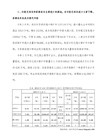
那么,为什么“小人”可以有几种译法,“君子”却只能用junzi来音译呢?这个于丹教授的译者没有解释,我只好猜测:“小人”的概念外国人很好理解,不乏对应的词汇;而中国坦荡荡的“君子”境界远非一个gentleman可以代表,所以只好用一个外国人几乎不会发音的词junzi来,《论语》出现的“小人”一词有24处,于丹《心得》中出现的“小人”应该比24次还要多很多。那么,这“小人”到底该怎么翻译呢?总不会是small man吧?
在英语版《心得》的第44页出现了“小人”。在首次提到的时候,就是用的small man,放在引号中作为直译,随后解释说就是small-minded(小心眼)或者second-rate people(不入流的人)。在《心得》中,于丹转引并翻译孔子的话说:“像这样的小人你能让他去谋国家大事吗?”这句话在英文版中是这样翻译的:Can you let this kind of petty individual plan great matters of state? 所以,在这里“小人”被翻译成petty individual(渺小的个人)。
在巴黎机场书店,看到署名Yu Dan的Le bonheur selon Confucius: Petit manuel de sagesse universelle(《孔夫子论幸福:普世智慧小手册》)和其它畅销书摆在一起。这不是于丹教授的《论语心得》吗?
到了香港机场,照例逛书店,结果又看到了署名Yu Dan的Confucius from the Heart:Ancient Wisdom for Today's World(《心中的孔子:当今世界的古代智慧》),号称是10 million copy international bestseller。这不还是于丹教授的《论语心得》吗?这回,花了204元港币买了一本(英语正版书真是很贵啊),不为别的,就想知道英语版的《论语心得》是怎么翻译“君子”和“小人”这两个高难概念的——唯君子与小人为难译也。要知道,这是堂堂英国麦克米兰(Macmillan)公司约请英国专家Esther Tyldesley翻译的,绝对地道。
于丹论语心得英文读后感
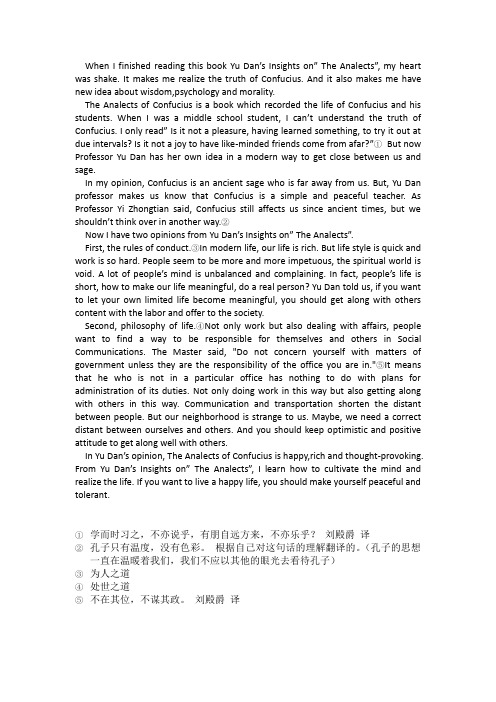
When I finished reading this book Yu Dan’s Insights on” The Analects”, my heart was shake. It makes me realize the truth of Confucius. And it also makes me have new idea about wisdom,psychology and morality.The Analects of Confucius is a book which recorded the life of Confucius and his students. When I was a middle school student, I can’t understand the truth of Confucius. I only read”Is it not a pleasure, having learned something, to try it out at due intervals? Is it not a joy to have like-minded friends come from afar?”①But now Professor Yu Dan has her own idea in a modern way to get close between us and sage.In my opinion, Confucius is an ancient sage who is far away from us. But, Yu Dan professor makes us know that Confucius is a simple and peaceful teacher. As ProfessorYi Zhongtian said, Confucius still affects us since ancient times, but we shouldn’t think over in another way.②Now I have two opinions from Yu Dan’s Insights on” The Analects”.First, the rules of conduct.③In modern life, our life is rich. But life style is quick and work is so hard. People seem to be more and more impetuous, the spiritual world is void. A lot of people’s mind is unbalanced and complaining. In fact, people’s life is short, how to make our life meaningful, do a real person? Yu Dan told us, if you want to let your own limited life become meaningful, you should get along with others content with the labor and offer to the society.Second, philosophy of life.④Not only work but also dealing with affairs, people want to find a way to be responsible for themselves and others in Social Communications. The Master said,"Do not concern yourself with matters of government unless they are the responsibility of the office you are in."⑤It means that he who is not in a particular office has nothing to do with plans for administration of its duties.Not only doing work in this way but also getting along with others in this way. Communication and transportation shorten the distant between people. But our neighborhood is strange to us. Maybe, we need a correct distant between ourselves and others. And you should keep optimistic and positive attitude to get along well with others.In Yu Dan’s opinion, The Analects of Confucius is happy,rich and thought-provoking. From Yu Dan’s Insights on”The Analects”, I learn how to cultivate the mind and realize the life. If you want to live a happy life, you should make yourself peaceful and tolerant.①学而时习之,不亦说乎,有朋自远方来,不亦乐乎?刘殿爵译②孔子只有温度,没有色彩。
【心得体会】于丹论语心得-处世之道心得体会
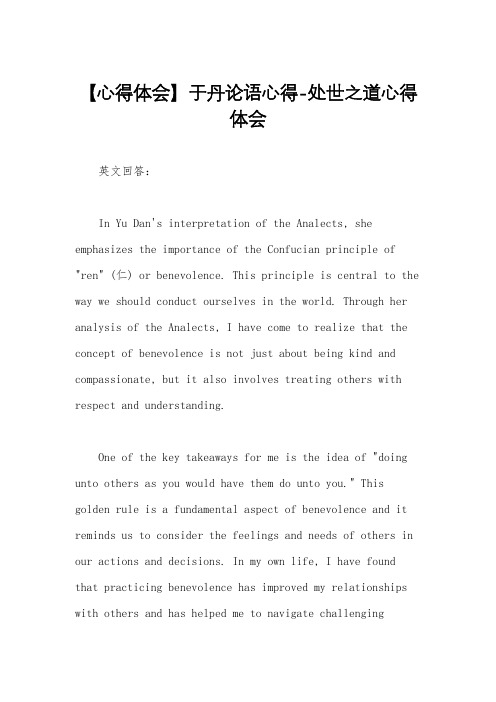
【心得体会】于丹论语心得-处世之道心得体会英文回答:In Yu Dan's interpretation of the Analects, she emphasizes the importance of the Confucian principle of "ren" (仁) or benevolence. This principle is central to the way we should conduct ourselves in the world. Through her analysis of the Analects, I have come to realize that the concept of benevolence is not just about being kind and compassionate, but it also involves treating others with respect and understanding.One of the key takeaways for me is the idea of "doing unto others as you would have them do unto you." This golden rule is a fundamental aspect of benevolence and it reminds us to consider the feelings and needs of others in our actions and decisions. In my own life, I have foundthat practicing benevolence has improved my relationships with others and has helped me to navigate challengingsituations with empathy and grace.Another important lesson from Yu Dan's interpretationis the concept of "zhong yong" (中庸) or the Doctrine of the Mean. This idea of finding balance and harmony in all aspects of life resonates with me deeply. It reminds me to avoid extremes and to seek moderation in my thoughts and behaviors. By striving for zhong yong, I have been able to cultivate a sense of equilibrium and stability in my life, which has brought me a greater sense of peace and contentment.Overall, Yu Dan's insights into the Analects have provided me with valuable guidance on how to navigate the complexities of human relationships and the challenges of everyday life. Her emphasis on benevolence and the Doctrine of the Mean has inspired me to strive for a more compassionate and balanced way of living.中文回答:在于丹对论语的解读中,她强调了儒家的“仁”的重要性。
【心得体会】于丹论语心得-处世之道心得体会
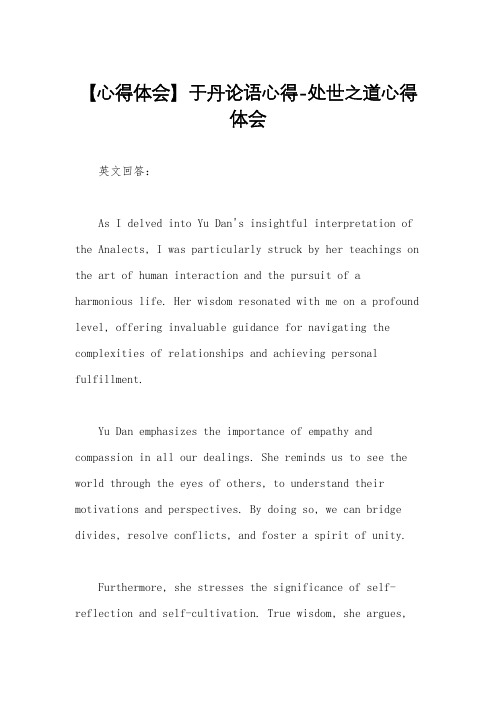
【心得体会】于丹论语心得-处世之道心得体会英文回答:As I delved into Yu Dan's insightful interpretation of the Analects, I was particularly struck by her teachings on the art of human interaction and the pursuit of a harmonious life. Her wisdom resonated with me on a profound level, offering invaluable guidance for navigating the complexities of relationships and achieving personal fulfillment.Yu Dan emphasizes the importance of empathy and compassion in all our dealings. She reminds us to see the world through the eyes of others, to understand their motivations and perspectives. By doing so, we can bridge divides, resolve conflicts, and foster a spirit of unity.Furthermore, she stresses the significance of self-reflection and self-cultivation. True wisdom, she argues,lies not only in acquiring knowledge but in applying it to our own lives. By examining our thoughts, words, and actions, we can identify areas for improvement and striveto become better versions of ourselves.In my own life, I have witnessed firsthand the transformative power of Yu Dan's teachings. I have made a conscious effort to practice empathy by actively listeningto and trying to understand the viewpoints of others. This has not only improved my communication skills but has also enabled me to build stronger, more meaningful relationships.Additionally, I have embraced the practice of self-reflection. By regularly journaling and seeking feedback from trusted friends and mentors, I have gained a deeper understanding of my strengths, weaknesses, and areas for growth. This has allowed me to set meaningful goals and make positive changes in my life.中文回答:在拜读了于丹老师对《论语》的精妙解读后,我感触颇深。
- 1、下载文档前请自行甄别文档内容的完整性,平台不提供额外的编辑、内容补充、找答案等附加服务。
- 2、"仅部分预览"的文档,不可在线预览部分如存在完整性等问题,可反馈申请退款(可完整预览的文档不适用该条件!)。
- 3、如文档侵犯您的权益,请联系客服反馈,我们会尽快为您处理(人工客服工作时间:9:00-18:30)。
第17卷第12期江苏技术师范学院学报JOURNAL OF JIANGSU TEACHERS UNIVERSITY OF TECHNOLOGYVo l.17,No.12Dec .,20112011年12月2006年“十一”期间,中央电视台《百家讲坛》栏目邀请北京师范大学于丹教授解读《论语》,引起了热烈的讨论。
同年11月,中华书局根据节目蓝本出版发行了《于丹〈论语〉心得》(以下简称为《心得》),该书创下了月销售100万册的奇迹。
在国内大获成功的同时,中华书局积极向海外输出版权,最终与英国麦克米伦出版公司(Pan M acmil-lan Ltd)达成协议,并邀请爱丁堡大学亚洲文化研究中心学者Esther Tyldesley 担任翻译。
2009年5月,该书英文版Confucius from the Heart ———An-cient Wisdom for Today ’s World 由中华书局与英国麦克米伦公司全球同步出版发行。
据2010年7月30号《人民日报》报道,《心得》英译精装本23万册半年销售告罄,业绩惊人,大获成功。
[1]本文尝试从翻译规范的角度,运用以色列学者图里(Toury Gideon )的翻译规范理论解读这本译作的成功之处。
一、图里翻译规范理论及其涵义图里是特拉维夫学派的代表人物之一,其代表作为Descriptive Translation Studies and Beyond ,该书主要涉及了以下几个方面的研究:描写翻译研究与翻译规范,个案研究和译者培训。
翻译规范是图里研究的理论基础和核心。
图里将翻译规范分为初步规范(preliminary norms )、首要规范(initial norms )和操作规范(operational norms )。
初步规范包括翻译政策和翻译直接性的考虑,初步规范在翻译活动还没有开始前就发挥了作用。
首要规范决定一部译作的整体取向,是遵守源语的语篇关系和规范或者译语的语篇关系和规范。
图里指出大部分的作品都不会处于两个极端,决定较少地牺牲源语文化规范的译作对于译入语来说是一种充分翻译(adequate translation );保留较多源语文化规范的翻译对于译入语文化来说是一种可接受翻译(acceptable translation)。
操作规范是实际翻译过程中的实际选择,即语言材料的模式和实际文字的表达。
[2]二、《心得》英译本与图里翻译规范理论(一)初始规范的运作体现于作品的选择和译者的选择选择《心得》这部作品进行翻译的原因主要是收稿日期:2011-10-17作者简介:马宁(1986-),女,江苏兴化人,09级语言文学专业硕士研究生,主要研究方向为翻译研究与文化研究。
从图里翻译规范理论看《于丹〈论语〉心得》英译本马宁(贵州大学外国语学院,贵州贵阳550025)摘要:扼要介绍图里的翻译规范理论,从初始规范、首要规范和操作规范这三个方面解释《于丹〈论语〉心得》英译本的合理性以及独特之处,力图阐明以下要点:作品和译者的选择遵循了初始规范;英译本整体的西化风格受到了首要规范的影响;英译本的结构安排和措词受到了操作规范理论的指导。
关键词:《于丹〈论语〉心得》;规范理论;图里中图分类号:H315.9文献标识码:A文章编号:1674-8522(2011)12-0078-04源语作品的风格、国家推广政策以及西方国家的需求。
首先是这部作品在国内的成功,用质朴的语言解读经典,拉近了经典与普通民众的距离。
成功的原因有:“一是通俗,用一般群众能听懂的语言解说《论语》;二是:有趣,她用古今中外的故事、寓言以及点典型事例,来说明比较深奥的内容,对群众有很大的吸引力”。
[3]其次是《心得》不同于其它解读《论语》的作品。
国内其它解读《论语》的作品大都是从学术的角度,普通人很难读懂。
而且《论语》的英译本也是同样的问题,根据统计《论语》的各种译本有24种,但是作品的受众都是汉学家或者汉语言文学工作者,语言深奥难懂[4];除此之外,不同的译本存在着不同的语言文化问题,使得普通大众读者少之又少。
再次是响应国家政策的结果。
为了吸引世界对中国传统文化的关注,更加全面有效地宣传中国传统文化,2004年,国家正式启动了“中国图书对外推广计划”(China Book International)。
在此基础之上,2009年又全面推行“中国文化著作翻译出版工程”(Project for Translation and Publication of Chinese Cultural Works)。
通过对翻译费用、出版发行及推广给予资助,发挥中外传播中国文化的专家、学者、出版界人士的力量和优势,加大对中国文化著作的翻译出版力度,努力把中国优秀的文化转播到世界各地。
[1]中华书局积极向海外输出版权,发起对《心得》的翻译行为正是应了这个形势所需。
最后是西方世界好奇《心得》中讨论的孔子哲学思想对解决当今西方人面临的问题能否具有启示作用。
2008年美国次贷危机引发了全球范围内的经融危机,使世界经济受到了重创,国际金融危机的产生和发展是由其内在的文化危机从深层触发并推动的。
这次金融危机的“根源在于人们对利益的追求的不择手段和毫无节制”[5]。
应对金融危机就要从道德层面入手,改变西方世界一切以实用主义和自由主义为根本的文化观念。
怎么提升文化就是摆在西方人面前亟待解决的一个问题,中国的儒家文化在这个合适的契机显露出了作用,中国道德文化强调的利他精神和社会责任感可以弥补西方将自由和实用推向极端从而造成非理智地抛弃社会责任感的缺点。
[6]《心得》这部作品正是汲取了中国儒家思想的精华,表现为通俗易通的现代语言,为迷茫中的西方民众送去了心灵的慰藉,指明了前进的方向。
选择Esther Tyldesley(中文名狄星)为《心得》翻译和她的专业素质、生活经历以及工作态度有关。
Esther Tyldesley毕业于英国剑桥大学,中文专业,获得英国立兹大学应用翻学研究硕士学位,从2004年开始在英国的爱丁堡大学任教中文和中英互译。
狄星嫁了一位中国丈夫,并且在中国贵州的婆家生活了4年,对中国西南的风土人情有一定了解。
她还是一名译者,曾经翻译过英籍华人欣然的作品《好娘》。
[7]译者的选择自然和她自身的专业素质分不开,同时狄星敬业的态度也是作品获得成功不可或缺的因素之一。
“她曾经3次飞到中国,拿着译稿和于丹在宾馆一条一条地核实,最长的一次整整四天没有出宾馆,认真到了较真的地步”。
[8](二)首要规范体现于译文的整体风格译文的整体风格受到三方面因素的影响:译入语作品的受众、受众的母语及其文化风格和源语作品的风格。
《心得》英译本的受众是普通的大众读者而不是汉学家,正如于丹所说“如果在北师大的讲台上,她是决不会这样解读论语的”[9]。
将受众定位成普通的读者,那么就要采用简单通俗的语言,句子结构明了清晰。
中华书局(赞助商)对译稿提出了要求:“不仅要把意思翻译出来,而且能够传神,能够反映作者的文风,英语读者读到的应该是一篇漂亮的散文而不是一个译本。
”[8]在源语文化规范和译入语文化规范的取舍问题上,译者根据文本的实际情况掌握两种不同文化规范的的契合点,并且在译文中生动地表现出来。
译者没有刻板地固守原书的语序、措辞,而是在理解原文内涵的基础上,根据西方人的思维逻辑、知识背景、表达习惯大胆地进行了调整,真正在西方的语境下解读中国经典。
例如“君子之道”整个章节被译者分布到其他每个章节里面,因为“君子”是《论语》的核心词汇,每一章节都有涉及,这样就使得整部作品读起来更像是一位以英语为母语的作家一气呵成的作品而不是一本译作。
从这个层面讲,译者牺牲了较多的源语文化规范,但是在文化负载词的处理方法上,译者保留了较多的源语文化规范,例如“君子”“小人”“士”“气”的翻译,译者保留了较多的中国文化规范,甚至在译作中出现了两处中国的汉字的直接引用。
综合以上,译者在两第12期马宁:从图里翻译规范理论看《于丹〈论语〉心得》英译本79种不同的文化规范之间,根据作品的实际需要做出了合理的选择,即符合译入语读者的阅读习惯又在一定程度上保留了源语文化规范,达到了赞助商所提出的要求:能够反映作者文风的优美的散文[8]。
(三)操作规范体现在翻译过程中的实际抉择,包括模版规范和文本语言规范《心得》共分为:序(易中天)、天地人之道、心灵之道、处世之道、君子之道、交友之道、理想之道、人生之道、《论语》原文和后记共10个部分,译者将原作的后记作为译作的序,同时舍去了《论语》原文这个部分,变动最大的部分是将“君子之道”分布在有需要的各个章节里面。
译作的“Fore-word—Why Confucius”是译者根据原作后记的内容,并且做出了相应的改编而译成的。
从“over two thousand years ago”开始,按照时间顺序“just over two thousand years ago”、“a thousand years ago”逐步介绍了《论语》在中国历史上的影响,过度到“our society and our lives today”[10]提出了《论语》能够为当今社会提供点什么这样的问题,顺势而下道出了《心得》这部作品产生的缘由:“在日益繁忙而迷惑的物质文明中秉持名族的根性”。
译者这样的布局既使得外国的读者特别是第一次接触《论语》的读者在宏观上对《论语》这部作品有了一个把握,又为《心得》铺了一个叙,暗示读者:这部作品会不同于以往任何一部《论语》英译本,因为这是为普通的大众读者所解读的一本书,勇敢地读下去,你们会喜欢这本书的。
在文本的结构上,译者做了较大的调整,保留了较多的译入语的文化规范,英语文体结构紧凑,层次清楚,不同于中国散文的形散神俱,而且《心得》这本书是以电视演讲稿为蓝本编辑而成的,作出相应的调整是必须的,这样读者才有可能捧起这本书慢慢品味。
但是在文化负载词的处理上,译者保留了较多的源语文化规范。
文化负载词包含了中国的文化内涵,许多中国人耳熟能详的成语对于西方读者来说并不是容易理解的,但是《心得》英译本的目的是为了向西方传播中国的古典文化,不能为了迎合英语语言而放弃对中国文化的描述,所以译作既要保留中国特色,又要让西方读者对此感兴趣并且能够理解。
译者在这些方面的处理方法是非常值得借鉴的:用中国的汉语拼音表示,同时做进一步的解释。
例如:《三五历记》译成“San Wu Li Ji,our very early Chinese history, which includes stories of how the world was made.”;“阳清之气,阴浊之气”译为“the light,pure Yang essence;the heavy Yin essence”[10]。
